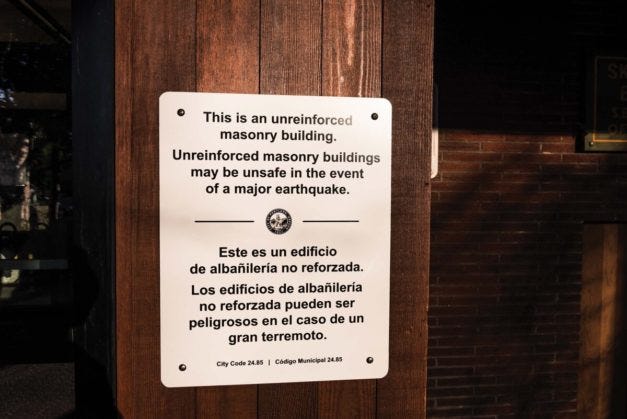Portland's Seismic Risk Awareness Ordinance
In 2019, the city of Portland, located in the western coastal state of Oregon in the US, enacted an ordinance aimed at increasing awareness of seismic risks posed by vulnerable buildings. However, prior to implementation, the City of Portland became embroiled in a legal dispute. Citizen groups contended that the seismic risk reduction ordinance violated their First Amendment rights, which are safeguarded by the US Constitution and guarantee freedom of speech.
This ordinance mandated owners of unreinforced masonry buildings (URM), among the most susceptible to earthquakes, to display placards stating,
"This is an unreinforced masonry building. Unreinforced masonry buildings may be unsafe in the event of a major earthquake."
Additionally, it required owners to inform both existing and prospective tenants in writing about the seismic risks associated with these buildings.

After an eventful hearing from both sides, a District Court of Oregon ruling halted enforcement of the ordinance's provisions1. Despite more than five years of effort by various public agencies to address seismic risks in older vulnerable buildings, the ordinance not only failed to advance seismic risk reduction efforts but instead set them back a few steps from their starting point.
Lapses in communication of risk through the ordinance
There are several threads that could be relevant to the topics of this series of essays, but I want to focus on risk communication. As a structural and earthquake engineering student, I've spent the past few years evaluating the vulnerabilities of buildings to seismic activity. It's undeniable that URM buildings are among the most seismically vulnerable structures worldwide. URM buildings are essentially buildings made of bricks or stones without any steel reinforcements, thereby lacking in capacity to withstand earthquake loading. A common prototypical URM building in the US (like the one shown in the figure below) is made of brick walls with wood-frame walls and roof. Unlike modern buildings in seismic regions designed to withstand earthquake loads, these structures were never intended for such resilience.

However, simply acknowledging the severe earthquake risk posed by these buildings isn't enough to spur action. While it's easy for earthquake engineers like myself to identify seismic vulnerabilities, earthquake risk is just one of many concerns facing our societies. Often, earthquake risks, like those associated with climate change, go unrecognized due to their inherent vagueness and the perception of unlikeliness.
A detailed court judgment evaluating the merits of the ordinance highlights several shortcomings. The ordinance fails to assist building owners or occupants in making decisions that would ensure their safety during earthquakes (drop, cover, hold on protocol). Consequently, there's no clear connection between the mandated placard message and reducing seismic risk. In fact, the identification and creation of the URM database was questioned for lack of transparency of method and process. Moreover, the ordinance targets only one type of seismically vulnerable building (URMs), ignoring other vulnerable building types present in Portland, such as older brittle concrete structures or buildings on poor soil.
City officials intended for mandatory placarding to raise awareness of seismic risk and, somehow, reduce future risk. Additionally, disclosure to existing and future tenants was expected to influence market decisions towards a less risky built environment. The court found this expectation of swaying the market “hypothetical” and pointed out that there was no clear connection to it with the placard mandate. While these intentions seem well-meaning, they grossly overlook equity concerns arising from potential ordinance implementation.
Complexities of understanding and communicating risk
The Portland example underscores the intricacy of risk communication and its potential for unintended consequences. This complexity transcends mere disaster scenarios, encompassing the broader notion of risk, which can be conceptually challenging. Risk, by its very nature, delves into a probabilistic realm that often diverges from our intuitive understanding. For instance, earthquake frequency is typically expressed in terms of return periods. Take, for example, the Cascadia subduction zone along the Oregon coast, capable of generating significant earthquakes. Its return period is roughly 500 years, suggesting that, on average, such an earthquake occurs every 500 years. Considering the relatively shorter span of human lifetimes, does this imply that we can dismiss the potential risk because we might not experience such an earthquake in our lifetime? Not quite. Estimates of the probability of a major earthquake from this source are higher than one might assume, around 14% within 50 years, according to a 2008 study2. This is more than enough probability to work towards a built environment with lower risk for our generation, if not for the future.
Yet, the shortcomings in risk communication evident in the Portland case extend beyond the challenges of conveying probabilities effectively. The issues raised during the court hearing shed light on the ordinance's failure to address Portland's seismic risk comprehensively. Neglecting equity concerns in implementing the ordinance proved to be a significant point of contention raised by civil society, and rightfully so. A review of the City of Portland’s policy indicated that the ordinance could disproportionately impact the most vulnerable section of society3.
Retrofitting and demolishing URM structures could lead to short-term displacement, particularly impacting low-income individuals. Without a systematic financing mechanism in place, the burden of reducing seismic risk may shift onto tenants through increased rents. These factors combined could contribute to gentrification. Consequently, many citizen groups have become skeptical, viewing these initiatives as systematic attempts to seize land for upscale developments at the expense of their homes. This perception has widened the gap between the administration and the public, making it challenging to bridge.
Ingredients of Successful Risk Communication
The literature on risk communication highlights several critical success factors: active dialogue, stakeholder engagement, understanding of affected groups, recognition of diverging values and ethical concerns, and awareness of how audiences perceive risk. A prominent essay on risk communication proposes four principles to improve communication strategies: maintaining sustainable resources and persistence for risk communication programs, integrating conflicting concerns into the design and structure of communication efforts, enhancing communication of key uncertainties that significantly impact risk, including identifying uncertainties that can or cannot be reduced over time, and finally, undertaking a comprehensive overhaul of communication goals, structures, and practices in contexts characterized by high social distrust, which is often encountered4. The following quote encapsulates the core essence of engaging with the public, especially in high public distrust scenarios:
In such situations [low public trust], it cannot be assumed that risk managers know what education or information is needed, or who may best provide it. Rather, if trust levels are low, then greater empowerment of those who will bear the risks is essential.
A researcher investigated the factors influencing the effectiveness of risk communication by interviewing practitioners from six Swedish government agencies5. The study revealed key themes such as organizational planning, collaboration, resource allocation, public trust, message delivery, and media engagement. However, the authors noted a technocratic bias among practitioners, as they tended to overlook elements identified in academic literature as crucial for successful risk communication, such as active dialogue, stakeholder engagement, and understanding of affected groups. Ethical considerations were also notably absent from their reflections during interviews, further reinforcing this bias. Additionally, the researchers observed a tendency among practitioners to adhere to an attribution theory, where success was attributed to internal factors like hard work and persistence, while failure was blamed on external factors such as audience deficiencies and media agendas.
Closing thoughts
This essay aims not to criticize the City of Portland's initiative to reduce seismic risk but rather to utilize it as a natural experiment to discern effective strategies. Aging infrastructure poses a significant concern for numerous earthquake-prone cities worldwide, particularly in North America. By examining Portland's example, we can gain valuable insights into effectively addressing the challenge of reducing the seismic risk posed by aging buildings and infrastructure in these regions.
Thank you for reading this essay and joining me on this journey of exploration. If you found it interesting and valuable, I would be grateful if you could share it with just ONE friend or colleague who may also find it intriguing.
18-2194 - Masonry Building Owners of Oregon et al v. Wheeler et al
Frankel, A. D., & Petersen, M. D. (2008). Appendix L: Cascadia Subduction Zone. US Geol. Surv. Open‐File Rept. 2007‐1437L.
Dukes, J., Seymour, Z., & Smith, D. A Review of Portland, Oregon’s URM Policy Recommendations and the Potential Impacts on Low-Income Communities. Lifelines 2022, 737-748.
Kasperson, R. (2014). Four questions for risk communication. Journal of Risk Research, 17(10), 1233-1239.
Boholm, Å. (2019). Lessons of success and failure: practicing risk communication at government agencies. Safety science, 118, 158-167.




Very good write up. Should be an eye opener for the authorities across the nations where many such structures proudly exist. Keep it up